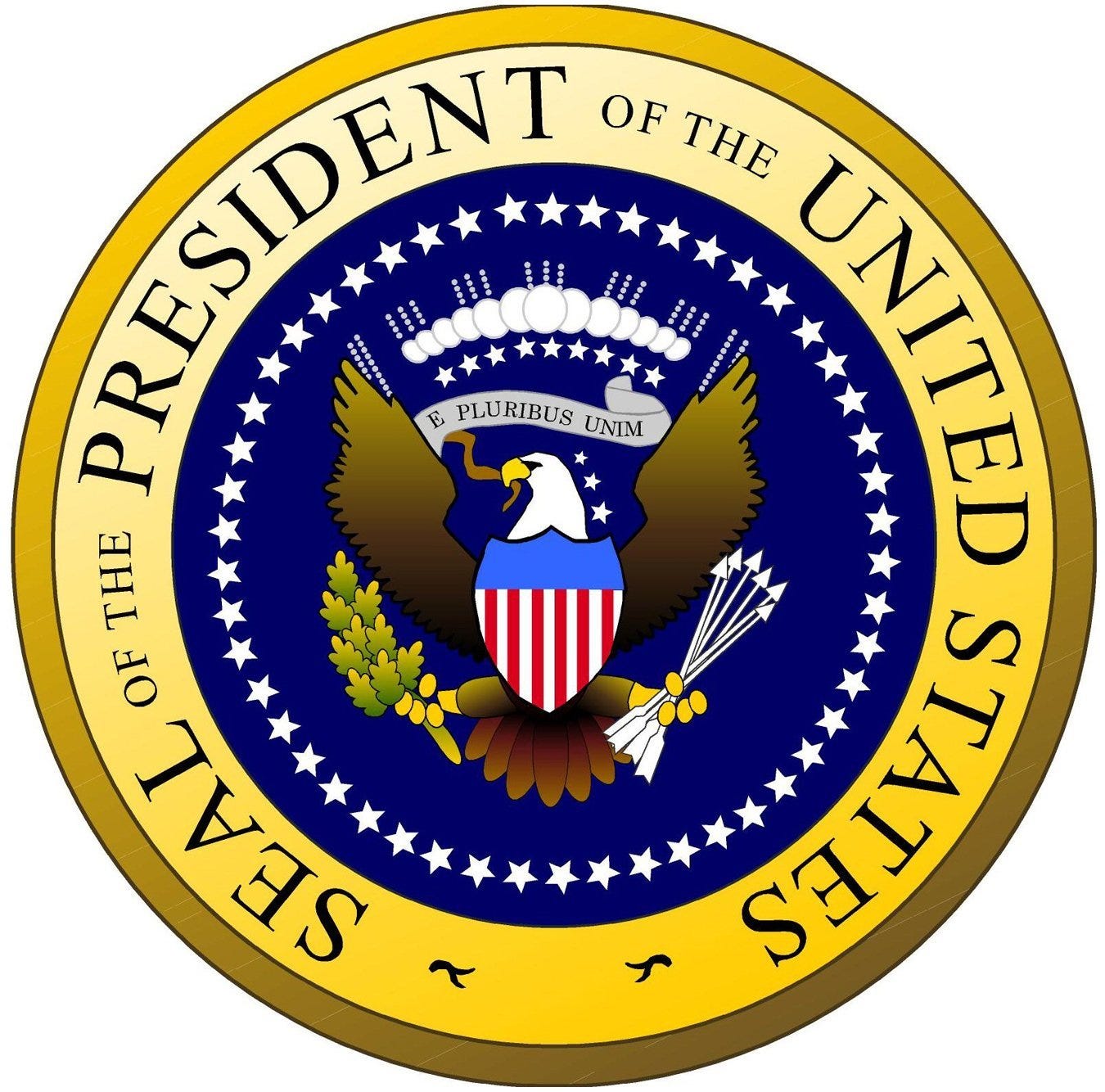The History of the "Peaceful Transition of Power"
Every incumbent president who lost reelection honored the transition, except one.
Issue #381 American History August 8, 2023
One of the hallmarks of the American presidential election system is the "peaceful transition of power," where the outgoing president assists the incoming president with the transition to a new administration. This transitional process is supposed to be smoothly enacted even if the outgoing president lost his reelection bid.
For over 200 years, this transition has occurred pretty much flawlessly, even when the outgoing president is understandably upset about his loss. That is, until 2020, when Donald Trump decisively lost his reelection bid, and not only hindered the transition but intentionally tried to delay the mandated counting of the electoral college votes on January 6, 2021.
The only other time there was not a peaceful transition of power after an election was in 1860 after Republican Abraham Lincoln was elected. The Southern Democrats were so upset with the results of that election that most states seceded from the Union.
George Washington, the first president of the United States, set the precedent for a two-term limit for presidents. Fearing the potential for monarchy-like rule, he declined to run for a third term in 1796, fostering the tradition of a two-term limit.
This tradition became law with the 22nd Amendment to the United States Constitution. After Franklin D. Roosevelt broke the two-term tradition by being elected to four terms, Congress passed the 22nd Amendment in 1947, and it was ratified by the necessary number of states in 1951.
The period following the Presidential election until the states certify their election results in December has several critical steps as defined by the Constitution.
On Election Day, citizens cast their votes. The votes are actually for electors for each party, and each state has a specified number of electors based on the most recent census.
Next, the state and local election officials count the votes, and the states then have until the "Safe Harbor" deadline, usually December 8, to resolve any disputes about the election results.
Then, each state certifies its election of the electors on December 14, when the official electors sign affidavits for the election of the president and vice president who won the state's popular vote.
The Constitution's 12th Amendment stipulates that the electors meet in their respective states and vote for President and Vice President on separate ballots, usually on December 14.
Finally, each state's electoral votes are then sent to the President of the Senate, the Archivist of the United States, and other designated federal and state officials.
“We Are Speaking,” which we publish seven days a week, is financially supported by our paid subscribers and by your investments in the products and services offered by the Global Creative Community Branding and Marketing Academy. Please make sure to view and act on the important information at the end of this article to help support and grow “We Are Speaking.” Thank you!
After the November election, the new Congress opens on January 3, and the entire Congress meets on January 6 for the official count of the electoral votes for president and vice president. The current vice president, in his or her ceremonial role as president of the Senate, is only supposed to count the electoral votes as provided by the Archivist. The vice president has no authority to delay or change the counting of the electoral college votes.
The 20th Amendment to the Consitution, also known as the "Lame Duck Amendment," set January 20 as the inauguration date for the new president and vice president. Prior to this amendment, the new president's term started on March 4. However, with advancements in transportation and communication, this long delay was deemed unnecessary. The change took effect in 1937 following the election of President Franklin D. Roosevelt for his second term.
The terms of the outgoing President and Vice President end at noon on the 20th day of January.
In 2013, because January 20 was on a Sunday, a private official swearing-in ceremony took place in the Blue Room of the White House, followed by a public inauguration ceremony on Monday, January 21, 2013, at the West Front of the United States Capitol.
Donald Trump is only the ninth president in American history to lose his reelection bid, but he is the first president to attempt to overturn the results of a fair and free election.
Here is a list of the incumbent presidents who lost their reelection bids and what they did after the transition to a new administration.
John Adams: The second U.S. president, John Adams, lost his reelection bid to Thomas Jefferson in 1800. After his term, Adams retired from politics and returned to his farm in Quincy, Massachusetts, where he spent the rest of his life writing letters and books until his death.
John Quincy Adams: Like his father, John Quincy Adams also lost his reelection bid in 1828 to Andrew Jackson. He went on to serve in the U.S. House of Representatives after his presidency, the only president to do so after leaving office, and became a leading opponent of slavery.
Martin Van Buren: In 1840, Van Buren lost his bid for reelection to William Henry Harrison. After leaving office, he tried but failed to regain the presidency, and he staunchly opposed the extension of slavery into new territories.
Grover Cleveland: Cleveland is the only president to serve two non-consecutive terms. He lost his bid for reelection to Benjamin Harrison in 1888 but reclaimed the presidency in the 1892 election.
Benjamin Harrison: Interestingly, Harrison, who defeated Cleveland in 1888, lost to him in the 1892 election. After his presidency, he returned to his law practice and wrote a book on the federal government.
Herbert Hoover: Hoover lost his reelection bid to Franklin D. Roosevelt in 1932 amid the Great Depression. After his presidency, he returned to business and wrote several books on economics and politics.
Jimmy Carter: Carter lost his reelection bid to Ronald Reagan in 1980. He set up the Carter Center in 1982 to promote and expand human rights. He has also engaged in diplomatic efforts, written numerous books, and worked with his Habitat for Humanity charity until just the last few months due to health issues.
George H. W. Bush: Bush lost his reelection bid to Bill Clinton in 1992. After leaving office, he retired from politics and devoted himself to charitable activities. On the day before the election, Bush was very upset as he realized he would lose, but on the next January 20, he left a beautiful note for his successor on the Resolute Desk, as is also a tradition.
Donald Trump is the only president in American history to refuse to have his administration participate in the official transition, the only president to openly attempt to delay the official count of the electoral college votes as they were submitted to the Archivist and to the Senate, and the only president to try to overturn the results of the election he lost.
The new president is supposed to be admitted to the White House by a member of the Marine Corps, but Trump, as the outgoing president and commander-in-chief, refused to order a Marine to be at the door as expected. When Joe and Jill Biden got to the White House after the Inauguration, the door was actually locked, and they had to wait for a Marine to open the White House door for them.
Let us know your thoughts about what new information you learned in the comments or in the Substack Notes feature.
You can always leave any questions in the comments or email us.
You can also receive up to six months of a paid subscription for referring people to us with the Share Button or the Refer Button.
This article is free to access for 1 week after publication. Please consider becoming a paid subscriber for $5/month or less to access all of the articles, the entire archive, and other benefits.
This is your chance to support everything Keith and Pam do. We appreciate you!
Purchase and download your copy of the “Branding And Marketing For The Rest Of Us” eBook for Independent Authors and Creative and Solo Professionals and other valuable eBooks.
Enroll in one of the 6-course bundles designed especially for you: “Author and Book Marketing” and/or “Essential Creative Marketing.”
Purchase your copies of “Detroit Stories Quarterly” issues.
Purchase your copies of “The Mayonnaise Murders” Parts 1, 2, and 3
What else do Keith and Pam do?
Where else can you find us?
Click the link below to learn everything you need to know and review everything we offer for independent writers and creative and solo professionals.









